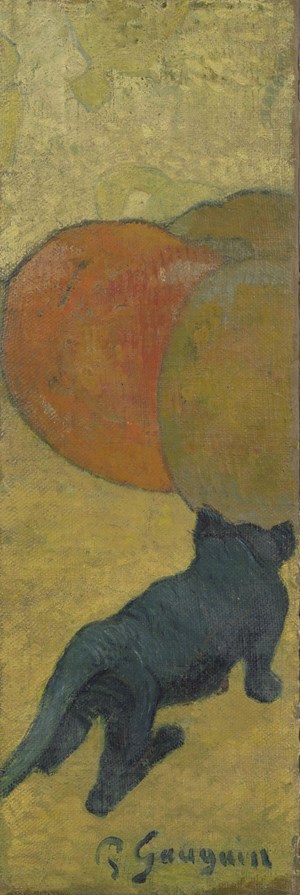
The painting The Little Cat (Le petit chat) (1888) by Paul Gauguin (1848-1903) is currently at the Van Gogh Museum on long-term loan and will be on display at the museum from today (19 December 2023). The work was last exhibited in 1906, and this is the first time the work will be shown together with paintings that Vincent van Gogh and Paul Gauguin made during the same period of intensive artistic exchange. The Van Gogh Museum plans to conduct extensive research on the work while it is on loan.
On 23 October 1888, Gauguin joined Van Gogh in Arles, in the South of France. The two artists spent the following nine weeks together in the ‘Yellow House’, where Van Gogh had his studio and where he dreamed of establishing a new artists’ community. He had high expectations of his time with Gauguin. They both made a large number of artworks there, and had profound discussions on the future of modern painting. This intense period of interaction greatly influenced how both artists developed. Gauguin left Arles shortly after Van Gogh cut off his ear following a heated argument with his companion on 23 December 1888, bringing their time together to an abrupt end.
The two artists were impressed with each other’s work. Gauguin admired Van Gogh’s still lifes; the Dutch artist worked on the third version of his famous Sunflowers during Gauguin’s stay. Gauguin himself also started work on a still life in which yellow was the dominant colour. In a letter to his brother Theo, Van Gogh wrote that Gauguin was working on ‘a big still life of an orange pumpkin and some apples and white linen on a yellow background and foreground’. A painting that matches Van Gogh’s description exactly is unknown, although it probably features in a portrait that Van Gogh made of Gauguin: a canvas can be seen to the right of the picture, with a yellow background and a spherical shape.
 Vincent van Gogh (1853 -1890) Portrait of Gauguin, 1888. Oil on jute on panel, 38.2 x 33.8 cm. Van Gogh Museum, Amsterdam (Vincent van Gogh Foundation)
Vincent van Gogh (1853 -1890) Portrait of Gauguin, 1888. Oil on jute on panel, 38.2 x 33.8 cm. Van Gogh Museum, Amsterdam (Vincent van Gogh Foundation)
The Little Cat was probably cut from what was originally a much larger canvas, which was the still life that Van Gogh mentioned in his letter. This would explain the unusual size and remarkable composition of this painting. The defined areas of colour and the absence of depth are typical of Gauguin’s painting style. Remarkably, Gauguin incorporated the little cat in many artworks made in different periods in his life. The Little Cat is painted on jute, as are many other works that the two artists made while at the Yellow House. In Arles Gauguin acquired a large roll of this unusual but cheap and course material.
The Little Cat was acquired by the avant-garde art collector Gustave Fayet (1865-1925). As well as his pre-eminent collection of works by Gauguin, Fayet was also one of the first collectors of Van Gogh’s work, acquiring eleven paintings in total, including several dating from the Arles period. Van Gogh Museum will be conducting extensive art-historical and technical research to unravel the story behind the painting.

ArtDependence Magazine is an international magazine covering all spheres of contemporary art, as well as modern and classical art.
ArtDependence features the latest art news, highlighting interviews with today’s most influential artists, galleries, curators, collectors, fair directors and individuals at the axis of the arts.
The magazine also covers series of articles and reviews on critical art events, new publications and other foremost happenings in the art world.
If you would like to submit events or editorial content to ArtDependence Magazine, please feel free to reach the magazine via the contact page.